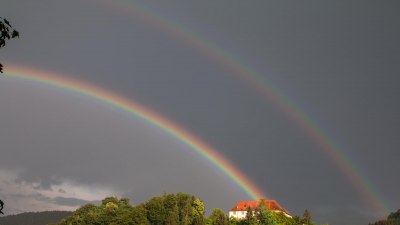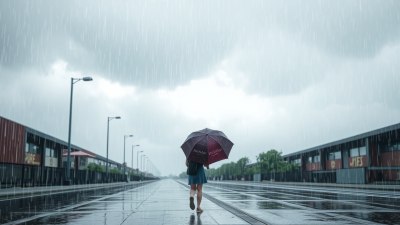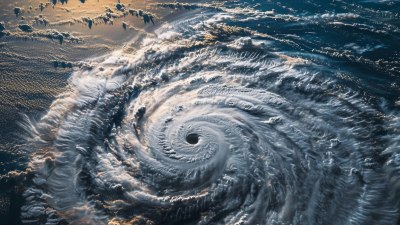What Causes the 'Second Rainbow' Effect
Explore the science behind the phenomenon of second rainbows and their stunning beauty.

Rainbows are one of nature's most captivating spectacles, and the phenomenon of second rainbows, or double rainbows, adds an extra layer of wonder to this optical illusion. A second rainbow appears outside the primary rainbow, featuring reversed colors and a fainter appearance. This article delves into the causes of this mesmerizing effect, explaining the science behind second rainbows and the conditions that lead to their formation.
Understanding Rainbows
To comprehend the cause of a second rainbow, we first need to understand how a primary rainbow forms. A primary rainbow is produced when sunlight passes through raindrops in the atmosphere. As light enters each droplet, it slows down and bends, a process known as refraction. The degree of bending depends on the wavelength of the light, which is why we see colors. Red light refracts the least and appears at the top, while violet light refracts the most and appears at the bottom.
Once the light is inside the droplet, it reflects off the inner surface before it exits back into the air. As it exits, it refracts again, further separating the colors. When this light reaches an observer’s eye from a specific angle—typically around 42 degrees from the direction opposite the sun—a rainbow is seen.
The Formation of a Second Rainbow
A second rainbow forms in a similar manner but involves an additional reflection inside the raindrop. When light enters the droplet, it undergoes the usual refraction and reflection to produce the primary rainbow. However, some of the light can reflect off the inner surface of the droplet a second time before exiting. This additional reflection causes the light to travel a longer path, resulting in a second arc of light outside the first rainbow.
The process involves the same principles of refraction and reflection as the primary rainbow, but with modified angles due to the double reflection. The colors are reversed, with red appearing on the inner edge and violet on the outer edge of the second rainbow. This inversion occurs because light reflecting an additional time in the drop alters its exit angle.
Why is the Second Rainbow Fainter?
One of the most noticeable characteristics of a second rainbow is its diminished brightness compared to the primary rainbow. This reduction in intensity occurs because of the extra reflection. Each time light reflects off a surface, some of its energy is lost due to absorption and scattering. Consequently, more reflections translate to less light available for our eyes, resulting in a fainter second rainbow. The light that manages to exit the droplet after two internal reflections is not only less concentrated but also scattered across a wider area, leading to the rainbow's subdued appearance.
Conditions for Observing Second Rainbows
Second rainbows can only be observed under specific conditions, typically following rain showers when sunlight breaks through clouds. The presence of countless raindrops in the air is essential, as they must be of a size capable of refracting the light sufficiently to create both primary and secondary rainbows.
The angle of the sun also plays a crucial role; it typically needs to be lower in the sky, often during early morning or late afternoon. Ideal conditions include a sunny day after rain, with scattered clouds to allow sunlight to penetrate while still maintaining a moist atmosphere. Under these circumstances, observers positioned with their backs to the sun can appreciate the beauty of a double rainbow.
Explaining the Color Reversal
The color reversal in a second rainbow results from how light interacts with water droplets through multiple reflections. In a primary rainbow, the spectrum follows the order of red, orange, yellow, green, blue, indigo, and violet (ROYGBIV) from the inside out. However, in the second rainbow, due to the nature of the double reflection, the order is reversed (VIBGYOR), with violet on the inside and red on the outside.
Atmospheric Conditions for Greater Visibility
The visibility of second rainbows can be enhanced under certain atmospheric conditions. For example, locations with minimal air pollution or dust in the atmosphere can lead to more vibrant rainbows, as these impurities can scatter light, reducing clarity.
Additionally, observing rainbows at high altitudes or locations with open skies allows for less atmospheric interference, further ensuring that the light remains unobstructed. The further away the observer is from urban pollution, the sharper and more distinct the rainbows, including any secondary ones that might occur.
Similar Phenomena: Supernumerary Rainbows
Beyond the second rainbow, another related phenomenon is the supernumerary rainbow, which consists of closely spaced, lighter arcs inside the primary rainbow. Unlike double rainbows, supernumerary rainbows arise from the diffraction of light, creating fringes of color rather than a full separate arc. This effect occurs when the raindrops are smaller and more uniformly sized, allowing interference patterns to add the additional light bands.
Cultural Significance of Rainbows
The appeal of rainbows—and second rainbows in particular—extends beyond mere scientific interest. Various cultures across the world regard rainbows as symbols of peace, harmony, and hope. They often appear in myths and legends, and a double rainbow can hold special significance, often seen as a lucky omen.
Capturing the Beauty of Double Rainbows
Photographers and nature enthusiasts are often captivated by the sight of double rainbows, striving to capture this elusive beauty. When photographing rainbows, it's essential to use the right techniques to highlight both the primary and secondary colors. Techniques include using a polarizing filter to reduce glare and showcase vibrant color saturation or capturing the scene at the right moment when the colors are vivid against darker, moody backgrounds.
Second rainbows are a stunning testimony to the wonders of light and nature. Their unique formation through the refraction and reflection of sunlight in raindrops captivates observers and adds an extra layer of beauty to an already splendid natural phenomenon. Understanding the science behind this effect not only enhances our appreciation of rainbows but also connects us to the intricate workings of the world around us. So, the next time you see a rainbow, look closely; you might just spot a secondary arc, adding a touch of magic to an already enchanting scene.











